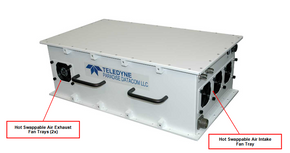

Request a quote at Contact@orbitalconnect.com or +1.888.315.9545
System Operation
The Outdoor PowerMAX system maintains complete parallel redundancy down to the embedded control level. Therefore the loss of an entire amplifier will not interrupt remote communications with the system. Remote communications can be either RS-485 or Ethernet. The system will automatically correct its gain level in the event of one or more amplifier failures. The sophisticated system monitor and control allows the system to be locally or remotely operated as if it were a “single” chassis amplifier. The system control maintains a hierarchical management that allows the operator to interface to a single chassis of the multi-module array. Another feature unique to Teledyne Paradise Datacom’s Outdoor PowerMAX is the introduction of “true rms” output power measurement. Unlike other amplifier systems that utilize diode detection schemes, the Outdoor PowerMAX reports the true rms output power of the system independent of the number of carriers and modulation schemes. Proprietary waveguide combining techniques are employed so that maximum power combining efficiency is optimized within the operating frequency band.
System Output Power and Configurations
The Outdoor PowerMAX system is typically used as a “self-redundant” system. The output power is sized such that the loss of (1) RF module’s power will still allow the system to maintain its minimum required output power. This type of system architecture is described as n+1 redundant. The system can be configured with any number of modules, but best overall efficiency is obtained with the popular binary combinations of 4 or 8 modules. It is very easy to upgrade the PowerMAX system from 4 modules to 8 modules in the field. It is not necessary to fully populate the system at the time of initial purchase. This provides the user a path to upgrade output power capability as system requirements grow, thus keeping capital investment minimized. For sizing redundant output power capability use the following guideline to determine the output power of the system with the loss of (1) module.
4 Module System - 3 of 4 Modules Operable = 2.5 dB loss in output power capability
8 Module System - 7 of 8 Modules Operable = 1.2 dB loss in output power capability
16 Module System - 15 of 16 Modules Operable = 0.6 dB loss in output power capability
Features
System is field scalable: i.e., can start out with (4) modules in system and upgrade to (8) modules.






System Operation
The Outdoor PowerMAX system maintains complete parallel redundancy down to the embedded control level. Therefore the loss of an entire amplifier will not interrupt remote communications with the system. Remote communications can be either RS-485 or Ethernet. The system will automatically correct its gain level in the event of one or more amplifier failures. The sophisticated system monitor and control allows the system to be locally or remotely operated as if it were a “single” chassis amplifier. The system control maintains a hierarchical management that allows the operator to interface to a single chassis of the multi-module array. Another feature unique to Teledyne Paradise Datacom’s Outdoor PowerMAX is the introduction of “true rms” output power measurement. Unlike other amplifier systems that utilize diode detection schemes, the Outdoor PowerMAX reports the true rms output power of the system independent of the number of carriers and modulation schemes. Proprietary waveguide combining techniques are employed so that maximum power combining efficiency is optimized within the operating frequency band.
System Output Power and Configurations
The Outdoor PowerMAX system is typically used as a “self-redundant” system. The output power is sized such that the loss of (1) RF module’s power will still allow the system to maintain its minimum required output power. This type of system architecture is described as n+1 redundant. The system can be configured with any number of modules, but best overall efficiency is obtained with the popular binary combinations of 4 or 8 modules. It is very easy to upgrade the PowerMAX system from 4 modules to 8 modules in the field. It is not necessary to fully populate the system at the time of initial purchase. This provides the user a path to upgrade output power capability as system requirements grow, thus keeping capital investment minimized. For sizing redundant output power capability use the following guideline to determine the output power of the system with the loss of (1) module.
4 Module System - 3 of 4 Modules Operable = 2.5 dB loss in output power capability
8 Module System - 7 of 8 Modules Operable = 1.2 dB loss in output power capability
16 Module System - 15 of 16 Modules Operable = 0.6 dB loss in output power capability
Features
System is field scalable: i.e., can start out with (4) modules in system and upgrade to (8) modules.